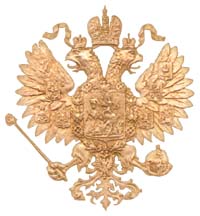- World
- History
 The Romanov double-headed eagle, looking both east and west, was reinstated as a Russian national symbol soon after the fall of communism. The Romanov double-headed eagle, looking both east and west, was reinstated as a Russian national symbol soon after the fall of communism. |
When Mikhail Romanov was placed on the throne of Russia in 1613, becoming the first Romanov tsar, the Russian empire was already vast, encompassing some 2.3 million square miles. By the time Nicholas II ascended the throne in 1894, becoming the last tsar, the Russian empire encompassed some 8.5 million square miles. At its height, the Russian empire stretched from Poland to Alaska and into California, encircling two-thirds of the globe, and encompassing the hereditary lands of scores of ethnic groups. The empire conferred on the Romanovs vast power and riches. It also confronted them with crushing logistic and administrative problems. For more than three centuries, the Romanovs managed to rule their vast empire as if they would govern Russia forever. Then, suddenly, they were gone.
The Romanov documents in the Hoover Institution Archives are extensive, running to thousands of papers and artifacts. Our Romanov holdings are also intensely personal, including items such as the correspondence of Nicholas II’s mother, the Empress Dowager Maria Feodorovna, and the diaries of his sister, Grand Duchess Xenia—letters and diaries that detail, from the Romanov family’s point of view, the events of the revolution, the July 17, 1918, assassination of the tsar, his wife, and their children, and the escape into exile of the surviving members of the family.
The imperial Russian collection was begun by Herbert Hoover himself. Hoover was intimately familiar with the geography and politics of Russia, where he invested in mining operations before the First World War, and in 1918, as news of the assassination of the imperial family spread, Hoover wrote to a colleague that the United States would have to struggle to “prevent Europe’s immolation in. . . anarchy such as Russia is plunged in today.” In 1920, eager to rescue documents that might otherwise be destroyed in the Russian unrest, Hoover commissioned Professor Frank Golder, an expert on the Romanov empire, to travel from Stanford to Russia, where Golder spent September 1921 to May 1923 collecting materials. Golder’s acquisitions remain among the most important in the Russian collection.
The collection has grown dramatically over the decades. One acquisition deserves particular mention. In 1936 a package was left at the Hoover Library, as it was then known, by a person who refused to identify himself. The unknown donor’s only demand: Keep the package sealed for twenty years. Reluctantly, the library staff agreed. Opened in 1960, the package contained documents assembled by the White Government—which opposed the Bolsheviks—in its investigation into the death of Nicholas and his family. The documents, part of a larger collection that was scattered as the Whites retreated during the Red Army’s advance in 1919 (parts of the collection can today be found in the State Archives of the Russian Federation, in an Orthodox cathedral in Brussels, at Harvard University, and in private collections), provided compelling, detailed evidence that the tsar and his family had been murdered. However, the burial site of the Romanovs remained undiscovered for six decades.
In October 1997, Russian geologist Alexander Avdonin visited the Hoover Archives to read the White files. A native of Ekaterinburg, where the Romanovs had been killed, it was Avdonin who located the Romanovs’ gravesite in 1979. Avdonin had secretly excavated the Romanovs’ remains but reburied them out of fear of the Soviet government’s reaction. The remains were finally exhumed on July 11, 1991, one day after Boris Yeltsin’s inauguration.







